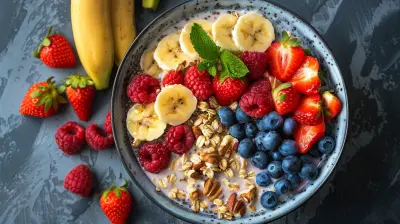How Strength Training Transforms Your Metabolism
15 March 2025
Let’s face it. When most of us think about strength training, we picture bulging muscles, intense gym sessions, and those grunting bodybuilders lifting insane amounts of weight. But what if I told you that strength training does so much more than just build muscle? In fact, one of its most underrated benefits lies in how it transforms your metabolism, turning your body into a fat-burning furnace. Sounds intriguing, right? Let’s dive into all the ways strength training can amp up your metabolism and why it might just be the game-changer you’ve been looking for.
What Is Metabolism, Anyway?
Before we dive into the nitty-gritty, let’s clear up what metabolism actually is. Think of it as your body’s engine. It’s the process by which your body converts the food and drink you consume into energy. Every single thing your body does—breathing, blinking, digesting that pizza you probably shouldn’t have eaten last night—requires energy. This energy-burning process is what we call your metabolism.Your metabolism has two main components:
- Basal Metabolic Rate (BMR): This is the number of calories your body needs to keep all its basic functions running while you’re chilling on the couch. It accounts for about 60-75% of the calories you burn daily.
- Activity Metabolism: This includes all the calories you burn through movement—whether it’s walking, running, or hitting the gym.
So, where does strength training fit into this picture? Oh, just in ways that’ll blow your mind. Let’s get into it.
How Strength Training Boosts Your Resting Metabolism (Yes, Even While You Nap!)
Strength training isn’t just about flexing in front of a mirror—it’s about breaking down and rebuilding your muscles. When you lift weights or do resistance exercises, you’re essentially creating tiny tears in your muscle fibers. Sounds painful, right? But don’t worry, it’s part of the process. Your body repairs and rebuilds those muscles, making them stronger and, here’s the kicker, bigger calorie burners in the long run.Here’s why:
Muscle tissue burns more calories at rest than fat tissue. Yup, you heard that right. Even when you’re binge-watching Netflix, muscles are working behind the scenes, churning through calories like it’s their full-time job. In fact, one pound of muscle can burn about 6 calories per day at rest, while a pound of fat burns just 2 calories. It might not sound like a lot, but those extra calories add up over time.
So essentially, the more muscle you build, the higher your resting metabolic rate (RMR). Translation? You’ll burn more calories 24/7—even while you’re sleeping. How cool is that?
The Afterburn Effect: Burning Calories Post-Workout
Here’s another mind-blowing perk of strength training: the afterburn effect. The science-y term for this is excess post-exercise oxygen consumption (EPOC), but let’s keep it simple. After a tough strength training session, your body needs extra oxygen to help your muscles recover and rebuild. This process demands energy, which means your body continues to burn calories long after you’ve racked those weights.How long does this calorie-torching bonus last? Research shows it can go on for up to 48 hours. So you’re essentially reaping the metabolic benefits of your workout for up to two days. Talk about getting the most bang for your buck, huh?
Bye-Bye Belly Fat: Strength Training Targets the Stubborn Stuff
Alright, let’s talk about the elephant in the room—belly fat. We all hate it, and we all want it gone. The good news? Strength training is one of the most effective ways to torch that stubborn fat.When you combine strength training with a healthy diet, your body begins to prioritize fat burning, all while preserving that lean muscle mass you’re working so hard to build. It’s like telling your body, “Keep the good stuff, lose the fluff,” and it listens. Plus, studies have shown that strength training can help reduce visceral fat, the dangerous kind that wraps around your organs and increases the risk of chronic diseases.
Hormonal Boosts: Why Weightlifting Keeps Your Internal System Balanced
Let’s give it up for hormones, the unsung heroes of your metabolism. When you’re strength training, you’re not just strengthening your muscles—you’re also giving your hormones a little kick in the right direction.For instance:
- Human Growth Hormone (HGH): This powerhouse hormone plays a role in fat metabolism, muscle growth, and overall recovery. Strength training naturally boosts HGH levels, helping your metabolism hum like a well-oiled machine.
- Insulin Sensitivity: Resistance training improves how your body uses insulin, which helps regulate blood sugar levels and prevents fat storage. Bonus points for reducing your risk of type 2 diabetes.
- Cortisol Reduction: Chronic stress can lead to elevated cortisol levels, which can slow your metabolism and promote fat storage, especially around the belly. Strength training helps reduce stress, keeping cortisol in check and your metabolism running smoothly.
Strength Training vs. Cardio: The Metabolism Debate
Now, I know what you’re thinking. “But doesn’t cardio burn more calories than strength training?” Fair point. A 30-minute run might burn more calories than a 30-minute weightlifting session, but here’s the thing: cardio’s calorie-burning benefits are mostly limited to the duration of your workout.With strength training, you’re not just burning calories during your session—you’re setting the stage for long-term calorie burn. Remember that afterburn effect we talked about? That’s not something you typically get with cardio. Plus, strength training helps you build and maintain muscle, which, as we’ve established, keeps your metabolism revving even at rest.
That said, the best approach is a combination of both. While strength training builds muscle and boosts metabolism, cardio improves heart health and burns calories. Together, they’re the dream team for overall fitness.
Strength Training for All: No Gym Membership Required
If you’re thinking, “But I don’t have time to go to the gym,” or “I don’t want to lift heavy weights,” don’t worry! Strength training is incredibly versatile and can be done almost anywhere. A few ideas:- Bodyweight Exercises: Think push-ups, squats, lunges, and planks. These don’t require any equipment and are super effective for building strength.
- Resistance Bands: These are affordable, portable, and fantastic for creating resistance without heavyweights.
- Dumbbells or Kettlebells: If you have access to these, they’re great for adding extra resistance to your workouts.
- Household Items: No equipment? No problem. Use water bottles, laundry detergent jugs, or even a backpack filled with books as makeshift weights.
The key is consistency. You don’t need to lift like a bodybuilder to see results. Just start with what feels comfortable and gradually increase the intensity as you get stronger.
Tips to Maximize Your Metabolism with Strength Training
If you’re ready to use strength training to supercharge your metabolism, here are a few tips to maximize your efforts:1. Focus on Compound Movements: Exercises like squats, deadlifts, and bench presses work multiple muscle groups at once, giving you more bang for your buck.
2. Don’t Skip Protein: Protein is the building block of muscle, so make sure your diet has plenty of it. Think lean meats, eggs, tofu, or protein shakes.
3. Consistency Is Key: Aim for at least 2-3 strength training sessions per week. Over time, you’ll start to see and feel the metabolic benefits.
4. Rest and Recover: Your muscles need time to recover and grow. Don’t overdo it—rest days are just as important as workout days.
5. Add Variety: Mix up your routine to keep things interesting and challenge your muscles in new ways.
The Long-Term Payoff: A Healthier, Leaner You
The beauty of strength training is that it’s not a quick fix; it’s a long-term investment in your health. By boosting your metabolism, preserving lean muscle, and torching fat, strength training helps you maintain a healthy weight and feel stronger, more energetic, and more confident. It’s not just about looking good—it’s about feeling good and giving your body the tools it needs to thrive.Final Thoughts: Strength Training Is Your Secret Weapon
Let’s cut to the chase: if you’re not already incorporating strength training into your routine, it’s time to start. Beyond the aesthetic benefits, it’s one of the most effective ways to transform your metabolism, improve your overall health, and keep your body working at its best. And the best part? You don’t need fancy equipment or hours at the gym to get started. Just a bit of effort, consistency, and determination can yield incredible results.So, what are you waiting for? Grab some weights (or a jug of water!) and let your metabolism know who’s boss.
all images in this post were generated using AI tools
Category:
Strength TrainingAuthor:

Laura Hudson
Discussion
rate this article
7 comments
Meredith Walker
Strength training optimizes metabolic efficiency.
April 7, 2025 at 5:01 PM

Laura Hudson
Absolutely! Strength training boosts muscle mass, which enhances metabolic rate and improves energy expenditure, leading to greater metabolic efficiency.
Brigitte McTier
“Strength training: because who doesn’t want their metabolism to work harder than a cat on a Roomba! Let's lift those weights and boost that burn!”
April 3, 2025 at 3:10 AM

Laura Hudson
Absolutely! Strength training revs up your metabolism, making it work more efficiently—just like that cat! Let's get lifting!
Giovanna Patel
Fascinating insights! I've always wondered how strength training impacts metabolism. Excited to learn more about its transformative effects!
March 21, 2025 at 3:50 PM

Laura Hudson
Thank you! Strength training can significantly boost your metabolism by increasing muscle mass, which in turn burns more calories at rest. I'm glad you're excited to learn more!
Madalyn Hayes
Thank you for sharing this insightful article! It's inspiring to see how strength training can positively impact our metabolism. For those of us on our fitness journeys, understanding these changes can be incredibly motivating. Here’s to embracing our strength and health!
March 20, 2025 at 5:50 PM

Laura Hudson
Thank you for your thoughtful comment! I'm glad you found the article inspiring and motivating on your fitness journey. Here’s to embracing our strength together!
Kieran McQuillan
Strength training is a game-changer for metabolism! By building muscle, it increases resting metabolic rate, helping you burn more calories even at rest. A must-try for anyone looking to boost their health!
March 19, 2025 at 3:40 AM

Laura Hudson
Absolutely! Strength training not only builds muscle but also enhances your metabolism, making it an essential component of any health program.
Callista McKee
Boosts metabolism effectively!
March 15, 2025 at 5:49 PM

Laura Hudson
Absolutely! Strength training increases muscle mass, which boosts your resting metabolic rate and enhances overall calorie burn.
Vex McKinstry
Strength training: turning metabolism into a turbo-charged squirrel ready to conquer your calories!
March 15, 2025 at 3:47 AM

Laura Hudson
Exactly! Strength training supercharges your metabolism, helping you tackle those calories with ease!





